Google builds 'brain' machine using memory like digital computers

A Google-owned company has built a device that combines the learning properties of a neural network with the computational ability of a computer. The combined architecture brings artificial intelligence technology closer.
Google bought the London-based DeepMind Technologies start-up for $400 million earlier this year. Now the company has revealed a prototype computer that mimics the way a human brain stores and recalls information in short-term memory.
The device called a Neural Turing Machine (NTM) is a novel kind of neural network. Such networks are similar to organic brains consisting of interconnected neurons. Rather than processing 0s and 1s like a digital computer, such a network transmits input signal under certain rules.
Neutral networks are good at finding patterns in information flow. The way our brain can easily recognize faces while regular computers can't is due to its neurons-based architecture. They can also be taught to complete tasks better than digital computers, which need programmer-generated code to execute a job.
The drawback of artificial neuron networks is that they can't work with memory the way digital computers can. Or at least couldn't before NTM was built.
“We have introduced the Neural Turing Machine, a neural network architecture that takes inspiration from both models of biological working memory and the design of digital computers,” says Alex Graves, Greg Wayne and Ivo Danihelka the scientists behind NTM.
DeepMind's device can access a large external memory much like the tickertape that passes back and forth through a Turing machine, a hypothetical device invented in 1936 by mathematician Alan Turing that gave NTM its name.
In their experiments, the researchers taught NTM to do simple sorting and copying tasks. A conventional neural network can learn to how to do them with a few pieces of information, but performance drops quickly as the task becomes harder.
The new device, after it learned to handle simple tasks, can use its memory access to help it deal with more complex tasks. The difference with conventional networks was significant, the researchers say.
Mating neural networks and digital computers has a great potential for creating a device that would work similar to a human brain, while having the number-crunching superiority of silicon processors. A computer like this could make programs for itself, writing code to do tasks it is not familiar with.
Google earlier announced a wide alliance between DeepMind and the University of Oxford on artificial intelligence research.














